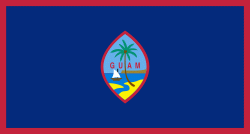Asan (Asan-Maina Village)
Asan is a community and census-designated place (CDP) along the western coast of the U.S. territory of Guam. Asan, along with Maina and Nimitz Hill Annex, are the three communities in the village of Asan-Maina. It is known for being the location of northern invasion beach used by the United States during the retaking of Guam in 1944.
Asan lies along the western coast of Guam along Asan Bay, facing the Philippine Sea. It is completely surrounded by the Asan Beach Unit and Asan Inland Unit of War in the Pacific National Historical Park. The village lies between Asan Point and Adelup Point. Guam Highway 1, better known as Marine Corps Drive, provides access to Piti to the west and Maina to the east. Nimitz Hill Annex on the Nimitz Hill highlands inland of Asan is not directly accessible by road. The Asan River flows through the western part of the community. A distinguishing feature is the large grassy park at Asan Point, which is actually across Marine Corps Drive from the community in the Asan Beach Unit of War in the Pacific National Historical Park.
Asan lies along the western coast of Guam along Asan Bay, facing the Philippine Sea. It is completely surrounded by the Asan Beach Unit and Asan Inland Unit of War in the Pacific National Historical Park. The village lies between Asan Point and Adelup Point. Guam Highway 1, better known as Marine Corps Drive, provides access to Piti to the west and Maina to the east. Nimitz Hill Annex on the Nimitz Hill highlands inland of Asan is not directly accessible by road. The Asan River flows through the western part of the community. A distinguishing feature is the large grassy park at Asan Point, which is actually across Marine Corps Drive from the community in the Asan Beach Unit of War in the Pacific National Historical Park.
Map - Asan (Asan-Maina Village)
Map
Country - Guam
 |
 |
People born on Guam are American citizens but are politically disenfranchised, having no vote in the United States presidential elections while residing on Guam. Guam delegates to the United States House of Representatives have no vote on the floor. Indigenous Guamanians are the Chamoru, historically known as the Chamorro, who are related to the Austronesian peoples of Malay archipelago, the Philippines, Taiwan, and Polynesia. But unlike most of its neighbors, Chamorro language is not classified as a Micronesian or Polynesian language. Rather, like Palauan, it possibly constitutes an independent branch of the Malayo-Polynesian language family. As of 2022, Guam's population is 168,801. Chamorros are the largest ethnic group, but a minority on the multi-ethnic island. The territory spans 210 mi2 and has a population density of 775 /mi2. The Chamorro people settled the island approximately 3,500 years ago. Portuguese explorer Ferdinand Magellan, while in the service of Spain, was the first European to visit the island on March 6, 1521. Guam was colonized by Spain in 1668. Between the 16th and 18th centuries, Guam was an important stopover for the Spanish Manila Galleons. During the Spanish–American War, the United States captured Guam on June 21, 1898. Under the 1898 Treaty of Paris, Spain ceded Guam to the U.S. effective April 11, 1899.
Currency / Language
| ISO | Currency | Symbol | Significant figures |
|---|---|---|---|
| USD | United States dollar | $ | 2 |
| ISO | Language |
|---|---|
| CH | Chamorro language |
| EN | English language |















